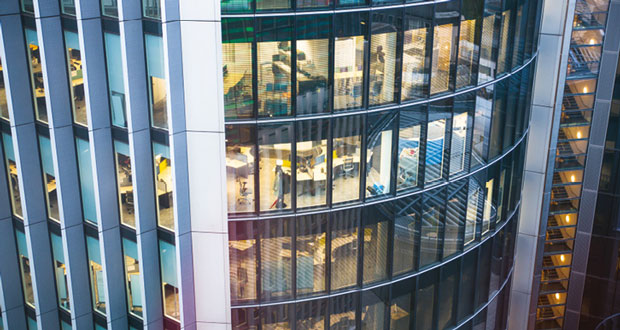The cost of occupying office space in the UK has risen to its highest level ever, according to property consultancy Lambert Smith Hampton (LSH). In response to inflationary pressures that have swept through the economy during 2022, the average cost of occupying new-build office space has increased by 13 per cent over the 12 months to September 2022. This represents the steepest annual rise in the survey’s 25-year history.
The figure is even starker for older (pre-2002) office buildings, where levels of efficiency are correspondingly lower, with costs rising by 18 per cent over the same period. Consequently, in many locations around the UK, energy costs for these buildings for the first time outstrip business rates liabilities.
In its annual Total Office Cost Survey, LSH analysed the total occupancy costs for offices in 54 key locations and found that of the 22 separate cost metrics, rent is typically the most influential factor in overall office occupancy costs. However, given the widespread inflationary pressures facing the UK economy, this year was a clear exception to the norm as double-digit inflationary rises across a host of ancillary costs have rendered any rental growth almost insignificant.
While energy costs drove the overall increase in total office costs, a host of other metrics saw considerable growth when placed in their historic context. Strong inflationary pressures in the construction industry were reflected in 20 per cent annual growth in fit-out costs, while in-house catering and printing/reprographics both increased by a substantial 28 per cent year-on-year.
Increased occupancy costs for older buildings are driving a flight to quality with rental growth for new-build offices rising by 6 per cent, up from 2.3 per cent in the preceding year and the strongest annual rise reported in the survey since 2016. By contrast, rents for older building increased by a modest 3.2 per cent since the previous year and experienced slower growth than newer builds for the fourth consecutive year.
Ryan Dean, head of transactional services at LSH, said: “We have now entered an era in which a host of previously negligible costs associated with office occupation are having an undue impact on businesses’ operational costs and, ultimately, bottom line”.
“As energy costs become a more influential factor in overall occupancy costs, it is no surprise that occupiers are seeking out better quality and more efficient buildings. This is good news from an environmental and sustainability perspective and many landlords and developers will be vindicated in their decision to make this a priority”.
According to Pitney Bowes Parcel Shipping Index, worldwide parcel volume is likely to double in the next five years, with the UK showing the highest increase in carrier revenue of all 13 countries in the Index.
Alongside a huge uptake in the volume of parcel volume and spend, post pandemic, the adoption of hybrid working patterns means that FMs need to find ways to enable staff to book / host collaborative meetings in available workspaces and to find desk, office and parking spaces by utilising automation and data capture to enable site governance.
Yet a recent survey by FMJ in partnership with Pitney Bowes found that 20 per cent of recipients are still using manual paper-based visitor systems, which doesn’t fit with their top priority – to maintain a safe and operational environment.
This overwhelming reliance on paper-based systems is causing many respondents bottlenecks, resulting in a lack of efficiently in logging and tracking packages and people coming into the organisation.
In this webinar, Gary Abbott Director of Business Development and Stuart Bushaway, Head of Dealers Operations and FM Relationships at Pitney Bowes will outline the main findings of the two surveys and what this could mean for FMs, followed by a discussion, chaired by FMJ Editor Sara Bean with a panel of thought leaders into the solutions available to meet these challenges.
Register for the webinar here.





